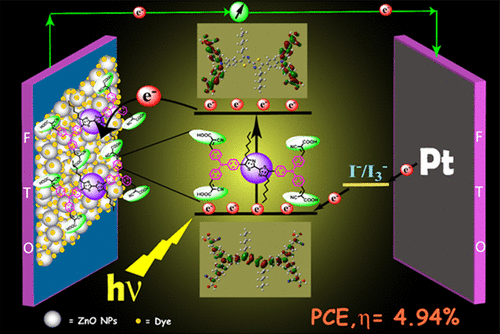Our official English website, www.x-mol.net, welcomes your feedback! (Note: you will need to create a separate account there.)
Cs-Symmetric Triphenylamine-Linked Bisthiazole-Based Metal-Free Donor–Acceptor Organic Dye for Efficient ZnO Nanoparticles-Based Dye-Sensitized Solar Cells: Synthesis, Theoretical Studies, and Photovoltaic Properties
ACS Omega ( IF 4.1 ) Pub Date : 2017-09-20 00:00:00 , DOI: 10.1021/acsomega.7b01100 Ramesh Maragani 1 , Mohammad Shaad Ansari 2 , Avishek Banik 2 , Rajneesh Misra 1 , Mohammad Qureshi 2
ACS Omega ( IF 4.1 ) Pub Date : 2017-09-20 00:00:00 , DOI: 10.1021/acsomega.7b01100 Ramesh Maragani 1 , Mohammad Shaad Ansari 2 , Avishek Banik 2 , Rajneesh Misra 1 , Mohammad Qureshi 2
Affiliation

|
Herein, we have designed a metal-free donor–acceptor dye by incorporating an electron deficient bisthiazole moiety as a linker in between the electron donor triphenylamine and cyanoacetic acid acceptor. The bisthiazole-based organic dye D1 was synthesized using the Pd-catalyzed Suzuki cross-coupling and Knoevenagel condensation reactions. On the basis of the optical, electrochemical, and computational studies, dye D1 showed a better electronic interaction between the donor and acceptor moieties. As-synthesized C2 symmetric triphenylamine-linked bisthiazole-based organic dye D1 has four anchoring groups, which play a significant role for better adsorption on the ZnO surface along with the enhanced kinetics of photoexcited electron injection. Consequently, photovoltaic properties of the organic dye D1 has been carried out by fabricating the ZnO nanoparticles (ZnO NPs)-based solar device. We obtained the maximum incident photon-to-current conversion efficiency of about 56.20%, with a short-circuit photocurrent density (Jsc) of 13.60 mA cm–2, which results in a power conversion efficiency (PCE) of 4.94% under AM 1.5 irradiation (100 mW cm–2). The high PCE value is the result of proficient electron injection from ELUMO of dye D1 to the conduction band of ZnO NPs, as suggested by the computational calculations. Electrochemical impedance spectroscopy measurement is carried out to calculate the electron lifetime and also reveals the insight to the reduced charge recombinations at the various active interfaces of the photovoltaic device.
中文翻译:

C s-对称的三苯胺连接的联苯并噻唑基无金属供体-受体有机染料,用于高效基于ZnO纳米粒子的染料敏化太阳能电池:合成,理论研究和光伏性质
在本文中,我们通过在电子供体三苯胺和氰基乙酸受体之间引入缺电子的联噻唑部分作为连接基,设计了一种无金属的供体-受体染料。使用Pd催化的Suzuki交叉偶联和Knoevenagel缩合反应合成了基于联噻唑的有机染料D1。在光学,电化学和计算研究的基础上,染料D1在供体和受体部分之间表现出更好的电子相互作用。合成后的C 2对称的三苯胺连接的联噻唑基有机染料D1具有四个锚定基团,它们对于更好地吸附在ZnO表面以及增强光激发电子注入的动力学起着重要作用。因此,通过制造基于ZnO纳米颗粒(ZnO NPs)的太阳能器件,已经实现了有机染料D1的光电性能。我们获得了约56.20%的最大入射光子-电流转换效率,短路光电流密度(J sc)为13.60 mA cm -2,在AM下的功率转换效率(PCE)为4.94% 1.5辐照(100 mW cm –2)。高PCE值是从染料D1的E LUMO中有效注入电子的结果计算计算表明,ZnO的导带达到ZnO NPs的导带。进行电化学阻抗谱测量以计算电子寿命,并且还揭示了对光伏器件的各种有源界面处的电荷复合减少的见解。
更新日期:2017-09-20
中文翻译:

C s-对称的三苯胺连接的联苯并噻唑基无金属供体-受体有机染料,用于高效基于ZnO纳米粒子的染料敏化太阳能电池:合成,理论研究和光伏性质
在本文中,我们通过在电子供体三苯胺和氰基乙酸受体之间引入缺电子的联噻唑部分作为连接基,设计了一种无金属的供体-受体染料。使用Pd催化的Suzuki交叉偶联和Knoevenagel缩合反应合成了基于联噻唑的有机染料D1。在光学,电化学和计算研究的基础上,染料D1在供体和受体部分之间表现出更好的电子相互作用。合成后的C 2对称的三苯胺连接的联噻唑基有机染料D1具有四个锚定基团,它们对于更好地吸附在ZnO表面以及增强光激发电子注入的动力学起着重要作用。因此,通过制造基于ZnO纳米颗粒(ZnO NPs)的太阳能器件,已经实现了有机染料D1的光电性能。我们获得了约56.20%的最大入射光子-电流转换效率,短路光电流密度(J sc)为13.60 mA cm -2,在AM下的功率转换效率(PCE)为4.94% 1.5辐照(100 mW cm –2)。高PCE值是从染料D1的E LUMO中有效注入电子的结果计算计算表明,ZnO的导带达到ZnO NPs的导带。进行电化学阻抗谱测量以计算电子寿命,并且还揭示了对光伏器件的各种有源界面处的电荷复合减少的见解。



























 京公网安备 11010802027423号
京公网安备 11010802027423号